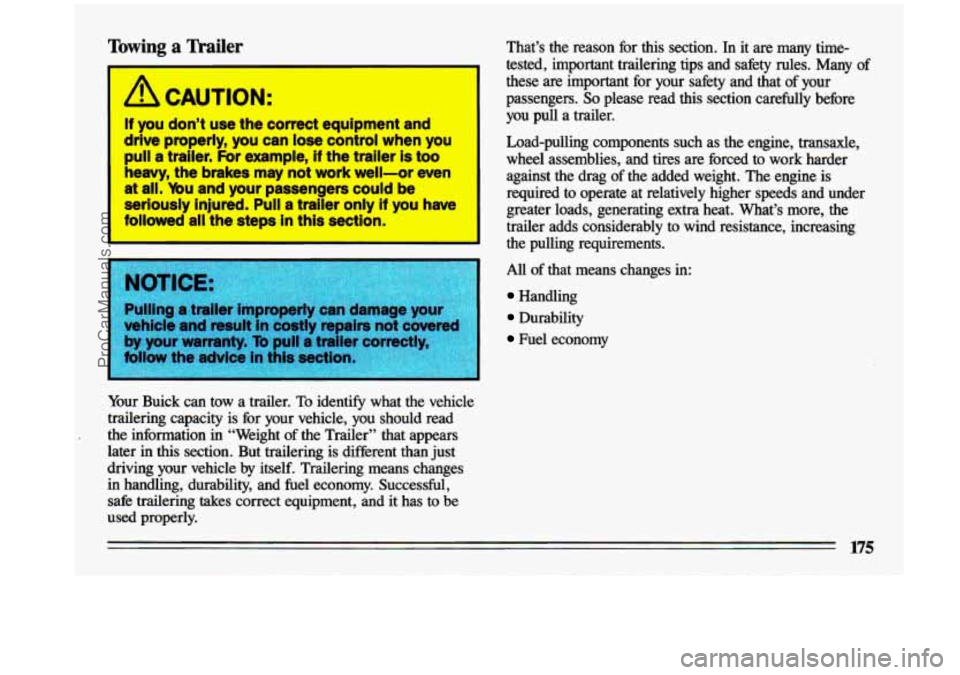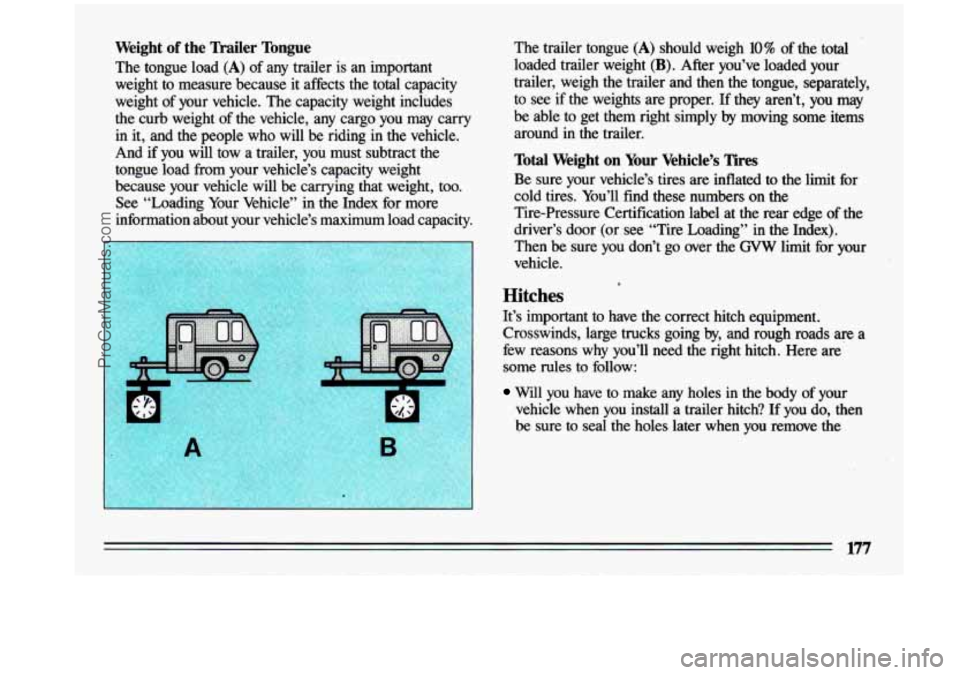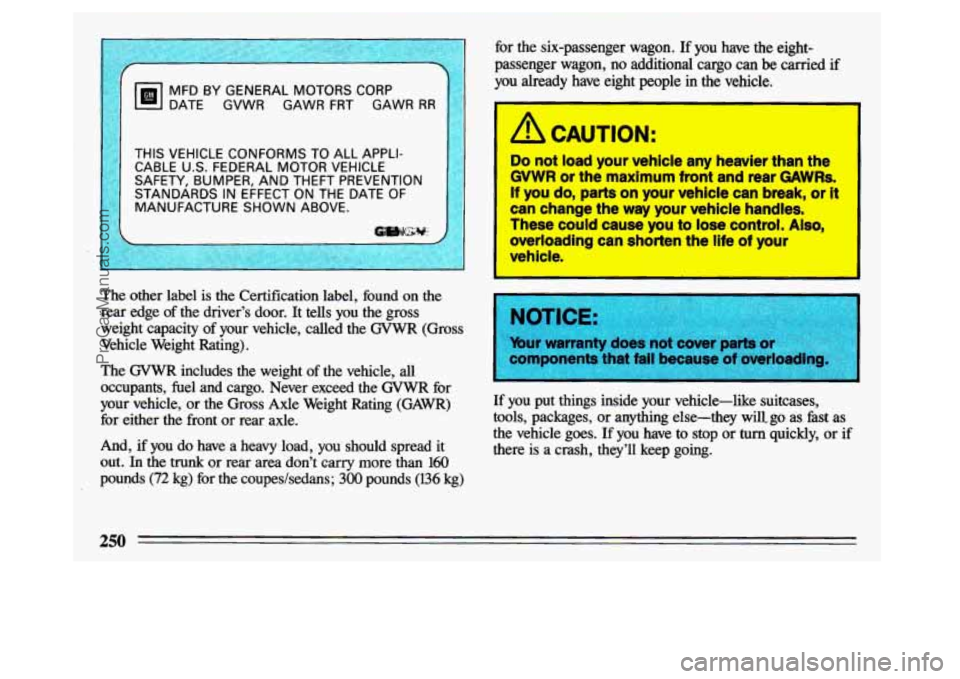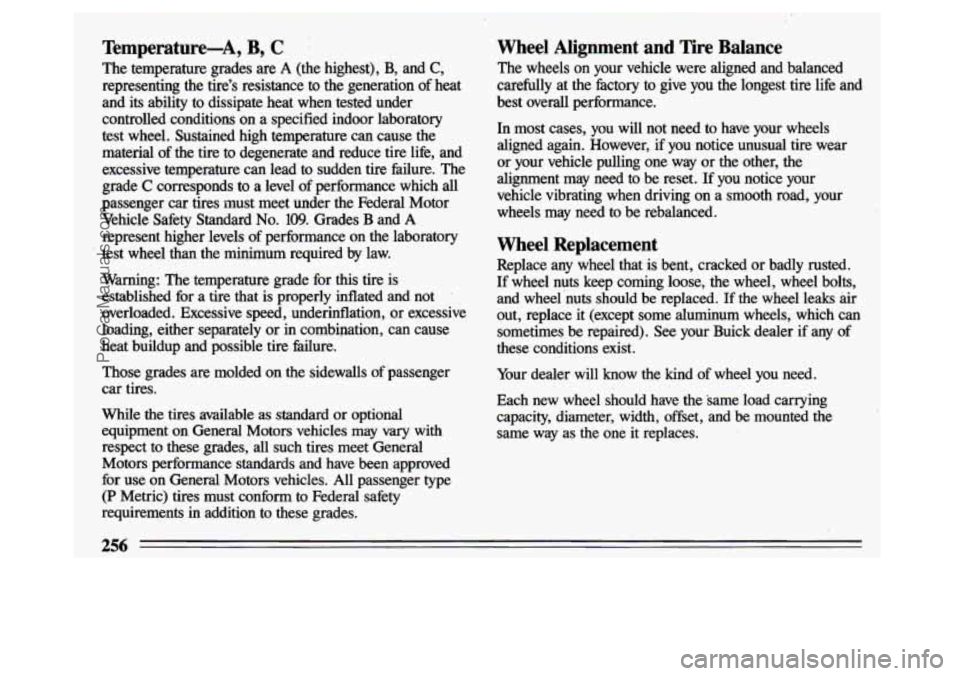1993 BUICK CENTURY load capacity
[x] Cancel search: load capacityPage 102 of 324

Sun Visors Luggage Carrier (Option)
To block out glare, you can swing down the visors. If you have
the optional luggage carrier, you can load
Visor Vanity Mirrors vehicle. The luggage cairier has slats attached to the deck
things
on top of a wagon,
or on the deck lid of your
- . lid, a rear rail, and tiedowns. The wagon has slats
attached to the roof, side rails, and adjustable crossrails.
The crossrails can be adjusted by loosening the screws.
After moving the crossrails, be sure to tighten the screws
securely.
Standard Mirror: Open the cover to expose the vanity
mirror.
Lighted Mirrors: If your vehicle has the optional lighted
vanity mirrors, the lights come on when you open the
cover. These can even be used for reading. Close the
cover to
turn out the lights. Don’t exceed the maximum vehicle capacity when loading
your Buick. For more information on vehicle capacity and loading,
see “Loading Your Vehicle” in the Index.
100
ProCarManuals.com
Page 177 of 324

Towing a Trailer
A CAUTION:
If you don’t use the correct equipment and
drive properly, you can lose control when you
pull a traller. For example, If the trailer is too
heavy, the brakes may not work well--or wen
at all. Mu and your passengets could be
seriously Injured. Pull a trailer only if you have
followed all the steps in this section.
hicle and result
Your Buick can tow a trailer. To identify what the vehicle
trailering capacity is for your vehicle, you should read
the information in “Weight of the Trailer” that appears
later
in this section. But trailering is different than just
driving your vehicle
by itself. Trailering means changes
in handling, durability, and fuel economy. Successful,
safe trailering
takes correct equipment, and it has to be
used properly. That’s the reason for this section.
In it are many time-
tested, important trailering tips and safety rules. Many
of
these are important for your safety and that of your
passengers.
So please read this section carefully before
you pull a trailer.
Load-pulling components such as the engine, transaxle,
wheel assemblies, and tires are forced to work harder against the drag of the added weight. The engine is
required to operate at relatively higher speeds and under
greater loads, generating extra heat. What’s more, the
trailer adds considerably
to wind resistance, increasing
the pulling requirements.
All of that means changes in:
Handling
Durability
Fuel economy
175
ProCarManuals.com
Page 179 of 324

Weight of the Trailer Tongue
The tongue load (A) of any trailer is an important
weight to measure because it affects the total capacity
weight of your vehicle. The capacity weight includes
the curb weight
of the vehicle, any cargo you may carry
in it, and the people who will be riding in the vehicle.
And if you will tow a trailer, you must subtract the
tongue load from your vehicle’s capacity weight
because your vehicle will be carrying that weight, too. See “Loading Your Vehicle” in the Index for more
information about your vehicle’s maximum load capacity. The trailer tongue
(A) should weigh 10% of
the total
loaded trailer weight
(B). After you’ve loaded your
trailer, weigh the trailer and then the tongue, separately,
to see if the weights are proper.
If they aren’t, you may
be able to get them right simply by moving some items
around in the trailer.
Total Weight on Your Vehicle’s Tires
Be sure your vehicle’s tires are inflated to the limit for
cold tires. You’ll find these numbers on
the
Tire-Pressure Certification label at the rear edge of the
driver’s door (or see “Tire Loading” in the Index). Then be sure you don’t go over the
GVW limit for your
vehicle.
Hitches
It’s important to have the correct hitch equipment.
Crosswinds, large trucks going by,
and rough roads are a
few reasons why you’ll need the right hitch. Here are
some rules
to follow:
Will you have to make any holes in the body of your
vehicle when you install a trailer hitch?
If you do, then
be sure to seal the holes later when you remove the
177
ProCarManuals.com
Page 251 of 324

Windshield Wiper Blade Replacement
-1
Replacement blades come in different types and are
removed in different ways. Here’s how to remove the type
with a spring release:
1. Pull the windshield wiper arm away from the
2. Press down on the spring with a screwdriver and pull
3. Push the new wiper blade securely onto tL wiper
windshield.
the blade assembly off the wiper
arm.
arm.
Loading Your Vehicle
G INFORMATION
VEHICLE CAP. WT.
FRT. CTR.
RR. TOTAL LBS. KG
MAX. LOADING
& GVWR SAME AS VEHICLE
1 CAPACITY WEIGHT XXX COLD TIRE
TIRE SIZE SPEED PRESSURE
RTG PSI/KPa
Two labels on your vehicle show how much weight it
may properly carry. The Tire-Loading Information label
found on the rear edge of the driver’s door tells you the
proper size, speed rating and recommended inflation
pressures for the tires on your vehicle. It also gives you
important information about the number of people that
,
can be in your vehicle and the total weight that you can
carry. This weight is called the Vehicle Capacity Weight
and includes the weight
of all occupants, cargo, and all
nonfactory-installed options.
249
ProCarManuals.com
Page 252 of 324

MFD BY GENERAL MOTORS CORP
DATE GVWR GAWR FRT GAWR
RR
THIS VEHICLE CONFORMS TO ALL APPLI- CABLE U.S. FEDERAL MOTOR VEHICLE
SAFETY, BUMPER, AND THEFT PREVENTION
STANDARDS IN EFFECT ON THE DATE OF
I MANUFACTURE SHOWN ABOVE. Qw&$;+#;
The other label is the Certification label, found on the
rear edge
of the driver’s door. It tells you the gross
weight capacity of your vehicle, called the GVWR (Gross
Vehicle Weight Rating).
The GVWR includes the weight of the vehicle, all
occupants, fuel and cargo. Never exceed the GVWR for
your vehicle, or the Gross Axle Weight Rating (GAWR)
for either the front or rear axle.
And, if you do have a heavy load, you should spread it
out.
In the trunk or rear area don’t carry more than 160
pounds (72 kg) for the coupeshedans; 300 pounds (136 kg) for the six-passenger wagon.
If you have the eight-
passenger wagon, no additional cargo
can be carried if
you already have eight people in the vehicle.
A CAUTION:
Do not load your vehicle any heavier than the
GVWR or the maximum front and rear GAWRs.
If you do, parts on your vehicle can brerak, or It
can change the way your vehicle handles.
These could cause you to lose control. Also,
overloading can shorten the life of your
vehicle.
If you put things inside your vehicle-like suitcases,
tools, packages, or anything else-they willgo as hst
as
the vehicle goes. If you have to stop or turn quickly, or if
there is a crash, they’ll keep
going.
250
ProCarManuals.com
Page 258 of 324

Temperature-A, B, C
The temperature grades are A (the highest), B, and C,
representing the tire's resistance to the generation of heat
and
its ability to dissipate heat when tested under
controlled conditions on a specified indoor laboratory
test wheel. Sustained high temperature can cause the material'of the tire to degenerate and reduce tire life, and
excessive temperature can lead to sudden tire failure. The
grade
C corresponds to a level of performance which all
passenger car tires must meet under the Federal Motor
Vehicle Safety Standard
No. 109. Grades B and A
represent higher levels of performance on the laboratory
test wheel than the minimum required by law.
Warning: The temperature grade for
this tire is
established for a tire that is properly inflated and
not
overloaded. Excessive speed, underinflation, or excessive
loading, either separately or in combination, can cause
heat buildup and possible tire failure.
Those grades are molded on the sidewalls of'passenger
car tires.
While the tires available as standard or optional
equipment on General Motors vehicIes may vary with
respect to these grades, all such tires meet General
Motors performance standards and have been approved
for use
on General Motors vehicles. All passenger type
(P Metric) tires must conform to Federal safety
requirements in addition to these grades.
Wheel Alignment and Tire Balance
The wheels on your vehicle were aligned and balanced
carefully at the, factory to give you the longest tire life and
best overall performance.
In most cases, you will not need to have your wheels
aligned again. However, if you-notice unusual tire wear
or your vehicle pulling one way or the other, the
alignment may need
to be reset. If you notice your
vehicle vibrating when driving on a
smooth road, your
wheels may need to be rebalanced.
Wheel Replacement
Replace any wheel that is bent, cracked or badly rusted.
If wheel nuts keep coming loose, the wheel, wheel bolts,
and wheel'nuts should be replaced. If the wheel leaks air
out, replace it (except some aluminum wheels, which can sometimes be repaired). See your Buick dealer
if any of
these conditions exist.
Your dealer will know the kind
of wheel you need.
Each new wheel should have the same load carrying
capacity, diameter, width, offset, and be mounted the same way as the one
it replaces.
256
ProCarManuals.com